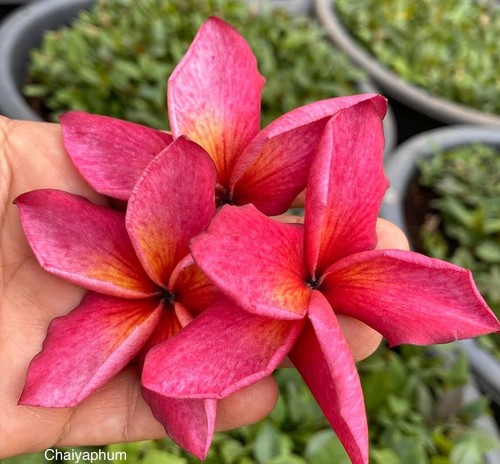Frangipani seed & loads of helpful advice
Frangipani seed
How to grow frangipani from seed:
1. Moisten the Frangipani Seeds
Freshly harvested seeds will germinate faster, while older seeds will take a longer time.
To hasten the germination process, the seeds need to be plumped up with moisture.
The easiest way is to place the seeds between moistened paper towels. Leave them for 24 hours in a warm environment. You will notice that the thicker part of the seeds will swell. The seeds will now be ready for sowing.
2. Prepare Potting Mix
Meanwhile, you can either prepare your own potting mix or buy it ready-made from a nursery. For this project, I used 'Seedling potting mix'.
3. Transplant the Swollen Seeds
Moisten the potting mix and make a small hole in the mix.
Gently push the plumeria seed about 0.2 inches (5mm) into the mix. Make sure the swollen end is at the bottom and the seed wing is at the top. Allow part of this wing to stick out of the soil.
Tenderly press the soil against the side of the plumeria seed.
4. Create a Mini Greenhouse Effect
Place these pots in an empty plastic container and cover it to create a mini greenhouse effect for these plumeria seeds to germinate. Place it in a warm, lighted area, but not under full sunlight.
Check daily to make sure the soil is not dry. If the top soil looks dry, mist it with water.
Place the pots in a plastic container. Then, cover the top to create a mini greenhouse effects for these plumeria seeds to germinate
5. Wait for the Seeds to Germinate
Depending on the freshness of the seeds, it will take from 5-7 days to over a month for them to germinate. Some people use a heat mat, others put their seeds in the plastic containers into their hot water cupboard to create a stable warm environment. If using a heat mat make sure you put a small block under the pot so that the seeds are not laying down on the full heat of the heat mat.
Most of the time, the leaf will emerge with the remains of the husk still attached. It will drop off as the leaves grow bigger.
If any of the seedlings show signs of mould (going black) during the germination process, treat it immediately with a mild fungicide e.g. a very weak solution of hydrogen peroxide with water.
6. Remove the Husk If It Sticks to the Cotyledons
The husk will usually fall off by itself, but occasionally this may not happen soon enough. If these husks are not removed from the cotyledons (i.e. the embryonic first leaves of the seedling), the seedlings might rot and die.
7. Once your seedlings are up to approx. 75mm tall repot into a pot on their own.
As they grow from here on repot only when the roots are coming out the bottom of the pot.
Posted: Friday 18 June 2021
| Top |



